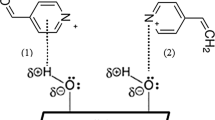Abstract
Traditional dyeing of cotton fabrics with reactive dyes has produced many environmental problems. Therefore, it is important to investigate the relationship between dye molecular structures and dyeing properties for cleaner procedures. Here, the properties of five azo-based reactive dyes with different substituents and reactive groups were studied. The dyes had similar molecular shapes, sizes, and chromophore structures. Differences were in the aromatic rings, the number of sulfonate groups, and the position of vinyl sulfonate on the benzene ring. The dye substantivity (S%), exhaustion (E%), reactivity (R%), fixation (F%), color strength, salt effects, alkali effects, and color fastness were investigated and analyzed. Different substituents on the dyes had a little effect on the ultraviolet-visible absorption maximum wavelength. In addition, the requirements of salt and alkali to produce the maximum color strength varied for different dye structures. The dye containing a naphthalene ring, three sulfonate groups, and a vinyl sulfonate at the para-position of the benzene ring produced the highest color strength and fixation values. Color fastness was almost the same for each dyed sample, except for the wet-rubbing fastness. The results should be useful for developing new dyes and environmentally friendly dyeing techniques.
Similar content being viewed by others
References
J. Široký, R. S. Blackburn, T. Bechtold, J. Taylor, and P. White, Carbohydr. Polym., 84, 299 (2011).
A. Shindy, Chem. Int., 3, 97 (2017).
S. Papić, N. Koprivanac, A. L. Bozic, and A. Meteš, Dyes Pigm., 62, 291 (2004).
B. Tang, S. Zhang, J. Yang, Y Tang, and J. Huang, Color. Technol., 120, 180 (2006).
K. Morris, D. Lewis, and P. Broadbent, Color. Technol., 124, 186 (2008).
T. Suwanich and P. Chutima, IOP Conf. Series: Materials Science and Engineering, 215, 012206 (2017). doi:https://doi.org/10.1088/1757-899X/215/1/012006
K. Bredereck and C. Schumacher, Dyes Pigm., 21, 23 (1993).
M. Irfan, H. Zhang, U. Syed, and A. Hou, J. Cleaner Prod., 197, 1480 (2018).
U. H. Siddiqua, S. Ali, T. Hussain, and H. N. Bhatti, Pol. J. Environ. Stud., 26, 2215 (2017).
K. Swaminathan, K. Pachhade, and S. Sandhya, Desalination, 186, 155 (2005).
T. Pálfi, E. Takács, and L. Wojnárovits, Water Res., 41, 2533 (2007).
W. Zhu, Z. Yang, and L. Wang, Water Res., 30, 2949 (1996).
C. Y. Zhong, A. H. Xu, B. Y. Wang, X. H. Yang, W. T. Hong, B. K. Yang, C. H. Chen, H. T. Liu, and J. G. Zhou, Colloids Surf., B, 122, 583 (2014).
J. A. Taylor, Color. Technol., 30, 93 (2000).
S. Chinta and S. VijayKumar, Int. J. Eng. Manage. Sci., 4, 308 (2013).
S. Burkinshaw and M. Paraskevas, Dyes Pigm, 88, 212 (2011).
A. Soleimani-Gorgani and J. Taylor, Dyes Pigm., 68, 109 (2006).
A. Soleimani-Gorgani and J. Taylor, Dyes Pigm., 68, 119 (2006).
K. Xie, A. Gao, M. Li, and X. Wang, Carbohydr. Polym., 101, 666 (2014).
U. H. Siddiqua, S. Ali, M. Iqbal, and T. Hussain, J. Mol. Liq., 241, 839 (2017).
J. Hamlin, D. Phillips, and A. Whiting, Dyes Pigm., 41, 137 (1999).
M. Hehlen, Text. Chem. Color., 10, 21 (1991).
H. Zhang, H. Yang, K. Xie, A. Hou, and A. Gao, Dyes Pigm., 159, 576 (2018).
A. K. Verma, R. R. Dash, and P. Bhunia, J. Environ. Manage., 93, 154 (2012).
S. J. Allen and B. Koumanova, J. Univ. Chem. Technol. Metall., 40, 175 (2005).
P. V. Nidheesh, R. Gandhimathi, and S. T. Ramesh, Environ. Sci. Pollut. Res., 20, 2099 (2013).
M. Nakahara, “The Science of Color”, Baifukan, 2002.
M. Montazer, R. Malek, and A. Rahimi, Fiber. Polym., 8, 608 (2007).
Author information
Authors and Affiliations
Corresponding author
Additional information
Acknowledgments
This work was financially supported by the National Key R&D Program of China (Grant No. 2017YFB0309600), and Shanghai Natural Science Foundation (Grant No. 18ZR1400800). We thank Alan Burns, PhD, from the Liwen Bianji, Edanz Group China (www.liwenbianji.cn/ac), for editing the English text of a draft of this manuscript.
Rights and permissions
About this article
Cite this article
Irfan, M., Xie, K. & Hou, A. Effect of Reactive Dye Structures and Substituents on Cellulose Fabric Dyeing. Fibers Polym 21, 2018–2023 (2020). https://doi.org/10.1007/s12221-020-9472-0
Received:
Revised:
Accepted:
Published:
Issue Date:
DOI: https://doi.org/10.1007/s12221-020-9472-0




